Welcome to “Plum Fruit Orchard Management: A Comprehensive Maintenance Guide for Month-wise Planning”! Whether you’re a seasoned orchardist or a beginner with a green thumb, this blog is your go-to resource for all things related to maintaining a flourishing plum fruit orchard. Managing an orchard can be overwhelming, especially when planning month by month.
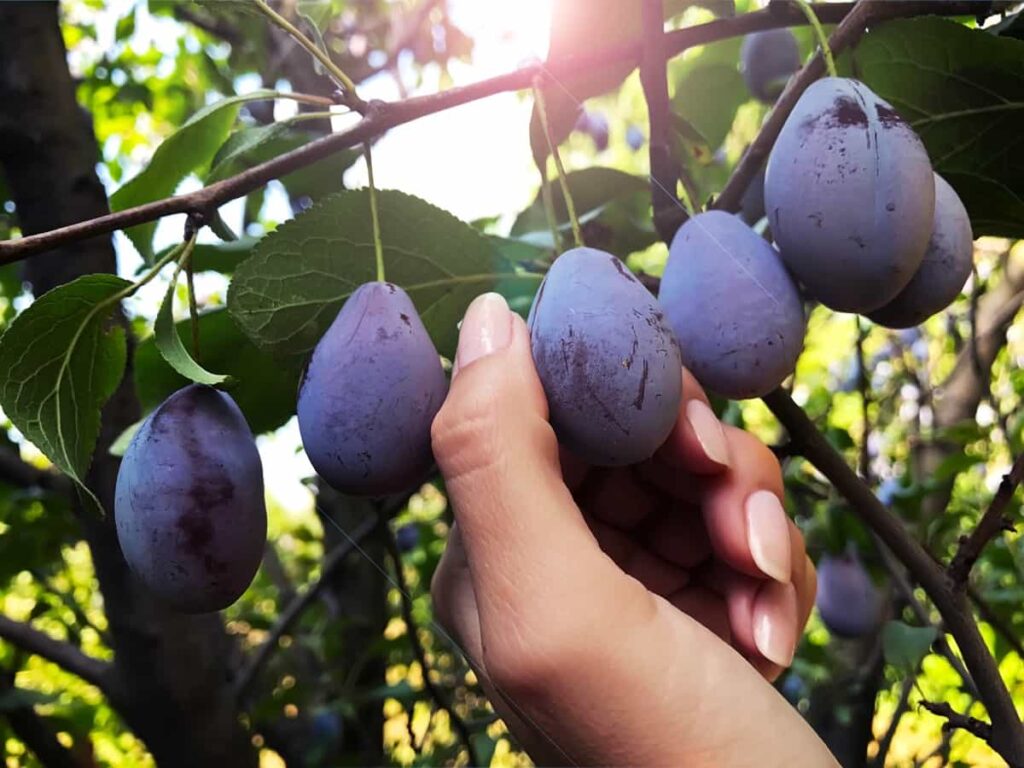
What is Plum Fruit Farming and its Overview?
Plum fruit farming is the cultivation of plums, which are fruits belonging to the Prunus subg. Prunus species. Prunes, often called dried plums, are a common form of plums in the United States. Plums are believed to have been among the first fruits domesticated by humans, originating in the East European and Caucasian mountains and China. They were later introduced to Britain from Asia and cultivated in Andalusia, southern Spain.
Plum trees, when pruned, can reach a height of 5-6 meters and produce drupe fruits with firm and juicy flesh. China is the largest producer of plums, followed by Romania and Serbia. Japanese or Chinese plums are popular for fresh consumption, while European plums are also prevalent in certain regions. Plums can be enjoyed fresh, used for making jams, or even fermented into wine or brandy.
It’s worth noting that plum kernels contain cyanogenic glycosides, but commercial availability of the oil derived from them is limited. Regarding nutrition, raw plums comprise 88% water, 12% carbohydrates, 1% protein, and less than 1% fat. They provide vitamin C but do not contain significant levels of other micronutrients.
Plums, a diverse group of fruit species, are commercially grown as medium-sized trees, usually pruned to 5-6 meters (16-20 ft). With moderate hardiness, they can reach heights of 12 meters (39 ft) if not pruned, spreading to 10 meters (33 ft). Blossoming time varies by region, occurring around January in Taiwan and early April in the United Kingdom. Plums are typically 2-7 centimeters (0.79-2.76 in) in diameter, with a firm, juicy flesh, and smooth peel that adheres to the fruit. They are drupes, with the fleshy part surrounding a single hard fruit stone enclosing the seed.
Importance of Month-Wise Planning for Plum Fruit Orchard Maintenance
Month-wise planning plays a crucial role in maintaining a plum fruit orchard. Each month brings different requirements and tasks that must be addressed for optimal orchard health and productivity. For instance, pruning is typically done during the dormant winter months to shape the trees and encourage fruiting.
In case you missed it: From Garden to Table: A Comprehensive Guide on Growing and Caring for Spaghetti Squash
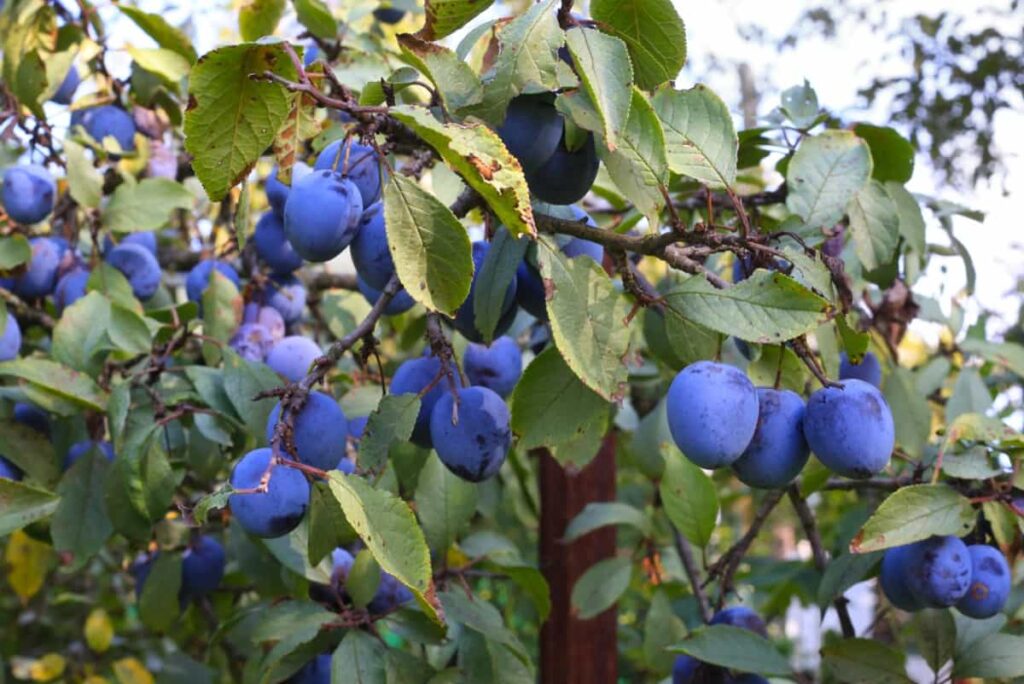
Spring is crucial for pollination and pest control, while summer requires careful irrigation and disease management. Harvesting occurs in late summer or early fall, followed by post-harvest activities such as orchard cleanup and tree preparation for the next growing season.
Best Tips for Growing Plum Fruit Orchards for High Profits and Yield
Growing plum fruit orchards for high profits and yield requires following certain tips and techniques. Plum, also known as “Aloo Bukhara,” is a sweet and tasty fruit found in hilly regions and the northern plains of India. It belongs to the Rosaceae family and Prunus domestica genus. Plums come in various sizes and shades of purple, with a fleshy interior and a seed. They are rich in antioxidants and vitamins and can be consumed fresh, dried, or jams.
There are two types of plums: European and Japanese, with over 200 varieties worldwide. In India, plum varieties developed are of Japanese origin and belong to the Prunus salicina group. These varieties require fewer chilling hours, have excellent taste, and can be consumed fresh. Some Indian plum varieties include Kala Amritsari, Satluj Purple, Titron, and Kataru Chak.
Plums thrive in a temperate climate, ranging from the freezing winters of Kashmir to the scorching summers of Rajasthan. They require fewer chilling hours below 7.2 degrees Celsius. The ideal soil for plum cultivation is deep, loamy, sandy soil with a neutral pH range of 5 to 6.5. Proper drainage is essential for productive plum orchards. Propagation of plum trees can be done through cuttings or seeds.
Hardwood cuttings are used for varieties like Kala Amritsari, while the Kabul Green variety can also be used for propagation. The success rate can be increased by using an IBA solution. Kala Amritsari seeds are collected during summer and sown in sandy soil. The seedlings are then transplanted in rows with proper spacing. Planting plum trees is typically done in December, with a distance of 6 meters between plants and rows.
Training and pruning techniques vary based on the variety, with open center systems and modified leader structures commonly used. Proper fertilization is crucial, with the application varying based on the age of the plant. Intercropping with crops like black or green gram, cluster beans, or peas can be beneficial. Fruit thinning should be done to ensure proper spacing between fruits.
Weed control using glyphosate is important, and water irrigation should be maintained from March to May for better fruit development. Harvesting should be done based on the desired ripeness. Locally sold plums can be picked when fully ripe, while those for transportation should be harvested when half skin color develops. Proper handling and packaging techniques should be employed to avoid damage during transportation.
Plum Fruit Orchard Management
Pruning is an essential aspect of plum fruit orchard management. Annual pruning helps renew the fruit wood, remove vigorous shoots known as “water sprouts,” and ensure adequate light penetration in the lower canopy. The most common training system for plums is the open center or vase-shaped system. Irrigation is crucial for plum orchards, although plums are less susceptible to fruit disorders caused by water stress compared to other stone fruit species like peach and nectarine.
In case you missed it: Optimizing Jackfruit Orchard Management: A Month-by-Month Operation Guide for Maximum Yield
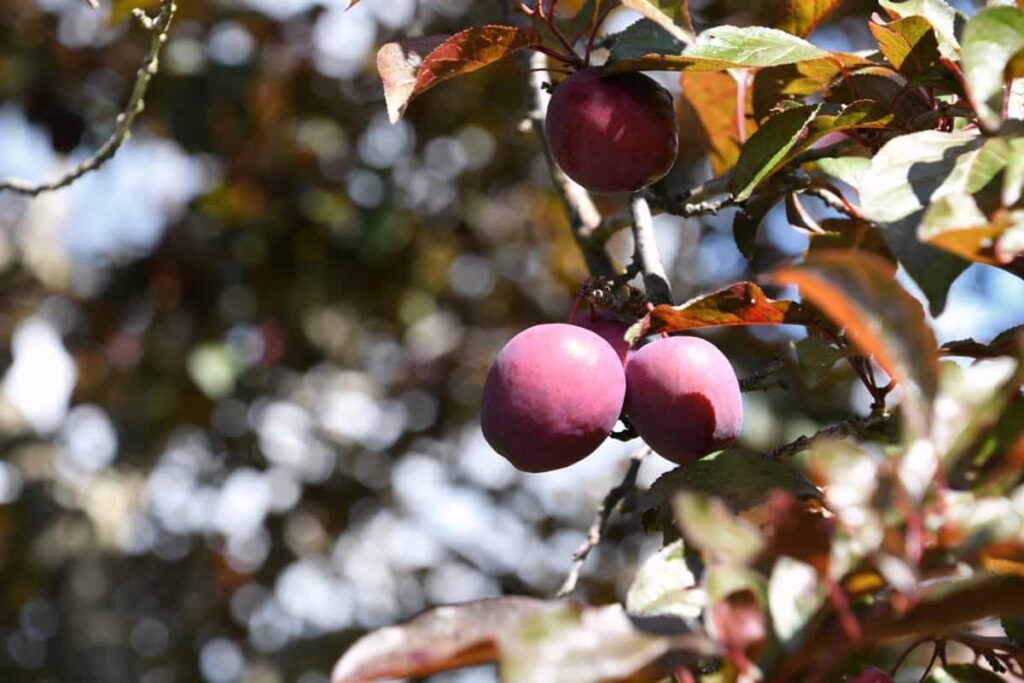
Drip or micro-sprinkler irrigation is typically used for plums, with some instances of flood irrigation in Central California. Cross-pollination is necessary for most Japanese plum cultivars as they are “self-incompatible,” meaning they require pollen from another compatible cultivar to set fruit. While some cultivars can achieve limited fruit sets without a pollinizer, commercial production requires adequate cross-pollination. Fruit set without pollinizers can vary across different geographic regions.
When planning an orchard, growers must consider local climate, soil conditions, pests, fruit characteristics, harvest timing, and pollination compatibility. California’s commercial nurseries provide recommendations for compatible cultivars. Pollinizer cultivars are usually interspersed with the primary cultivar in an orchard. The ratio of pollinizers to primary trees depends on the fruit quality and pollination requirements. Different planting strategies can be employed, such as alternating four-row blocks of pollinizer and primary cultivars or grafting pollinizer limbs onto the primary cultivar.
January Month Plum Fruit Orchard Maintenance Planning
In January, plum fruit orchard maintenance planning should focus on pruning activities. Renewing the fruit wood by removing old and unproductive branches is crucial. Prune the trees to maintain an open center or vase-shaped system, allowing for good light penetration in the lower canopy. Remove any water sprouts or vigorous shoots to encourage optimal growth and development of the tree.
February Month Plum Fruit Orchard Maintenance Planning
In February, continue pruning activities in the plum orchard. Remove any dead, damaged, or diseased branches. Prune to maintain the desired shape and structure of the tree. This will promote healthy growth and improve fruit quality. It is also a good time to inspect the trees for any signs of pests or diseases and take necessary management measures to control them.
March Month Plum Fruit Orchard Maintenance Planning
March is an important month for plum fruit orchard maintenance. Start preparing the orchard for the upcoming growing season. Begin by clearing any debris or fallen leaves from the orchard floor. This will help reduce the risk of pests and diseases. Inspect the trees for any signs of winter damage and make necessary repairs. It is also a good time to apply organic or synthetic fertilizers to provide the trees with essential nutrients.
In case you missed it: Carambola/Star Fruit Orchard Management: A Month-by-Month Maintenance Guide for Maximum Yield
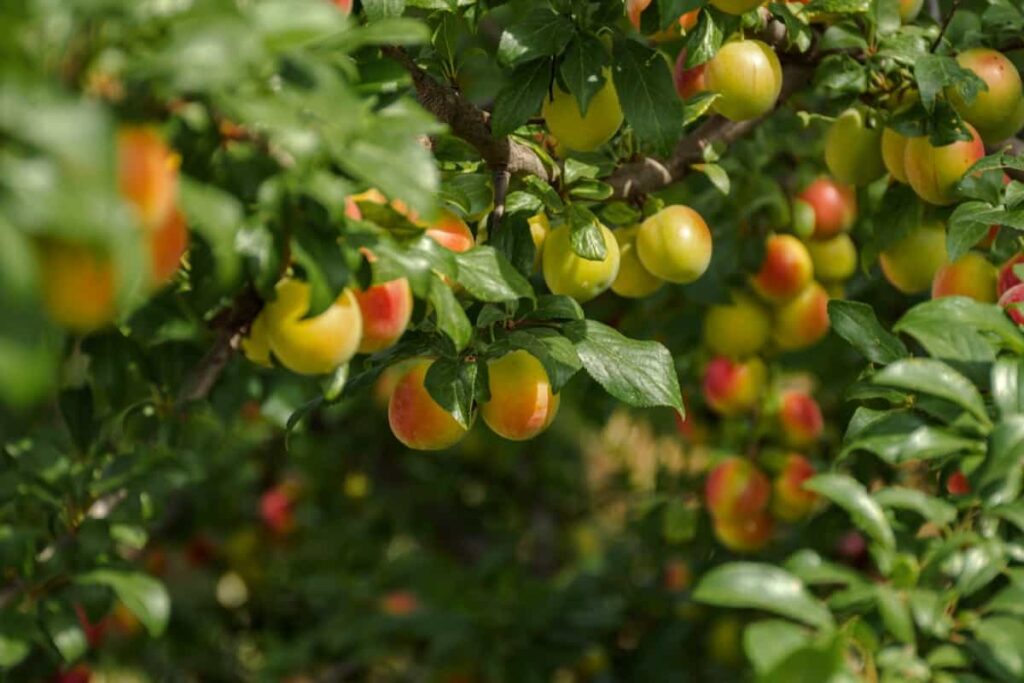
April Month Plum Fruit Orchard Maintenance Planning
In April, focus on pest and disease management in the plum orchard. Monitor the trees regularly for signs of pests, such as aphids, mites, or plum curculio. If necessary, implement appropriate pest control measures, including insecticides or biological controls. Also, watch for any signs of fungal or bacterial diseases and take preventive actions, such as applying fungicides or practicing good sanitation.
May Month Plum Fruit Orchard Maintenance Planning
May is a critical month for fruit development in the plum orchard. Adequate irrigation is essential to ensure optimal fruit growth and quality. Monitor soil moisture levels regularly and provide sufficient water to the trees, especially during dry periods. Mulching around the base of the trees can help retain moisture and suppress weed growth. Additionally, consider thinning the fruits to ensure proper spacing and promote better-sized and healthier plums.
June Month Plum Fruit Orchard Maintenance Planning
In June, continue monitoring the orchard for pests and diseases. Inspect the trees for any signs of insect infestation or disease symptoms. Take appropriate measures to control pests and diseases, including using targeted sprays or biological controls. Regularly monitor soil moisture and irrigation to ensure the trees receive adequate water during the growing season. Proper weed control should also be maintained to reduce competition for resources.
July Month Plum Fruit Orchard Maintenance Planning
July is a crucial month for pest and disease management in the plum orchard. Monitor the trees for common pests, such as plum moths or plum sawfly larvae. Implement effective pest control strategies, including the use of insecticides or pheromone traps. Regularly inspect the trees for signs of diseases like brown rot or bacterial spot and take necessary actions to prevent their spread. Proper irrigation and weed control should be continued.
August Month Plum Fruit Orchard Maintenance Planning
In August, focus on orchard hygiene and maintenance. Remove any fallen or rotting fruits from the ground to minimize the risk of disease spread. Prune the trees lightly to maintain their shape and remove dead or diseased branches. Continue monitoring for pests and diseases, and take appropriate measures for their control. Regularly irrigate the trees to ensure adequate water supply during the summer months.
September Month Plum Fruit Orchard Maintenance Planning
In September, prepare the orchard for the upcoming harvest season. Monitor fruit development and maturity regularly. Adjust irrigation and nutrient management practices accordingly to optimize fruit quality. Consider installing nets or other protective measures to prevent bird damage to the ripening fruits. Continue monitoring for pests and diseases, and take prompt actions to control any outbreaks. Harvest planning and logistics should also be organized.
October Month Plum Fruit Orchard Maintenance Planning
In October, the harvesting of plums begins. Harvest the ripe fruits carefully to avoid any damage. Sort and grade the harvested plums based on size, color, and quality. Proper handling and packaging techniques should be employed to maintain fruit freshness and prevent post-harvest losses. Clean the orchard by removing fallen fruits or debris to minimize the risk of pests and diseases.
In case you missed it: Optimizing Tamarind Orchard Management: A Month-by-Month Maintenance Guide for High Yields and Profit
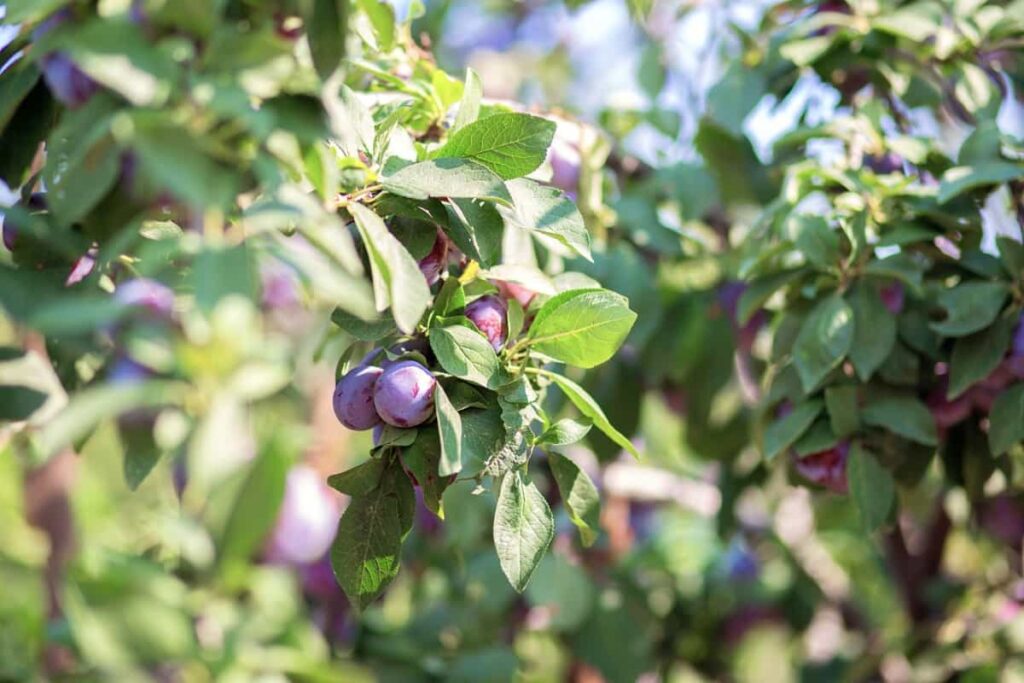
November Month Plum Fruit Orchard Maintenance Planning
In November, focus on post-harvest activities and orchard cleanup. Store the harvested plums in appropriate conditions to maintain their freshness and quality. Dispose of any damaged or spoiled fruits properly. Conduct a thorough inspection of the orchard for any signs of pests or diseases and take necessary measures to prevent their recurrence. Consider pruning the trees lightly to remove any unwanted growth or dead branches.
December Month Plum Fruit Orchard Maintenance Planning
December is a month of planning and preparation for the upcoming growing season. Review the performance of the orchard and evaluate the overall management practices. Make other adjustments to improve productivity and quality. Plan for the next year’s pruning schedule and orchard maintenance activities. Order necessary supplies and materials for the upcoming season. It is also a good time to attend educational programs or workshops related to plum orchard management to stay updated with the latest techniques and practices.
General Maintenance Operations and Management Practices in Plum Fruit Orchards
Rootstocks
- Sow peach or plum seeds in late October or early November. The seeds will sprout between February and March.
- Allow the seedlings to grow until they reach around 7 inches in length and 2mm in diameter.
- The shield budding technique is best suited for budding, which should be done from May to June.
Seed Collection and Sowing
- Collect seeds during summer and store them. Sow the accumulated seeds in sandy soil around November, with a 5cm thickness of sand covering the seeds for proper germination.
- Once shoots appear, transplant the seedlings in rows, maintaining a distance of 8-10cm between each plant and 25-30cm between the rows.
- Light irrigation is sufficient, and the plants will be ready for grafting the following year.
Planting
- After growing for approximately one year, the young shoots can be planted in the fields, preferably in December. Maintain a distance of 6 meters between the plants and rows.
- Adopt a square cultivation system, planting around 270-320 trees per hectare.
Training/Pruning
- Training depends on the variety, with open center systems suitable for spreading habit varieties (e.g., most Japanese varieties) and modified leader structures for upright growing plants.
- Alter the leader branches after four years of plantation and collect 4 to 5 secondary branches.
- Light pruning in January promotes proper growth, and good quality spurs development.
- Plum fruits appear after one year on older wood spurs.
Fertilizer Application
- Apply fertilizer according to the soil type, with loamy soil requiring more and hard soil requiring less. The fertilizer composition depends on the age of the plant.
- For 1-2-year-olds: 5-10 Kilos of Farmyard manure, 50-100 grams of Urea, 60-120 grams of Superphosphate, and 25-50 grams of potash.
- For 3-4-year-olds: 15-20 Kilos of Farmyard manure, 150-200 grams of Urea, 180-240 grams of Superphosphate, and 75-100 grams of potash.
- For 5-6-year-olds: 25-30 Kilos of Farmyard manure, 250-300 grams of Urea, 300-400 grams of Superphosphate, and 125-150 grams of potash.
- For seven years and older: 40 Kilos of Farmyard manure, 300 grams of Urea, 400 grams of Superphosphate, and 200 grams of potash.
- These maintenance operations and management practices are essential for ensuring the healthy growth and high-quality yield of plum fruit orchards.
In case you missed it: Exploring the Essence of Korean Natural Farming (KNF): Harmony in Soil and Soul
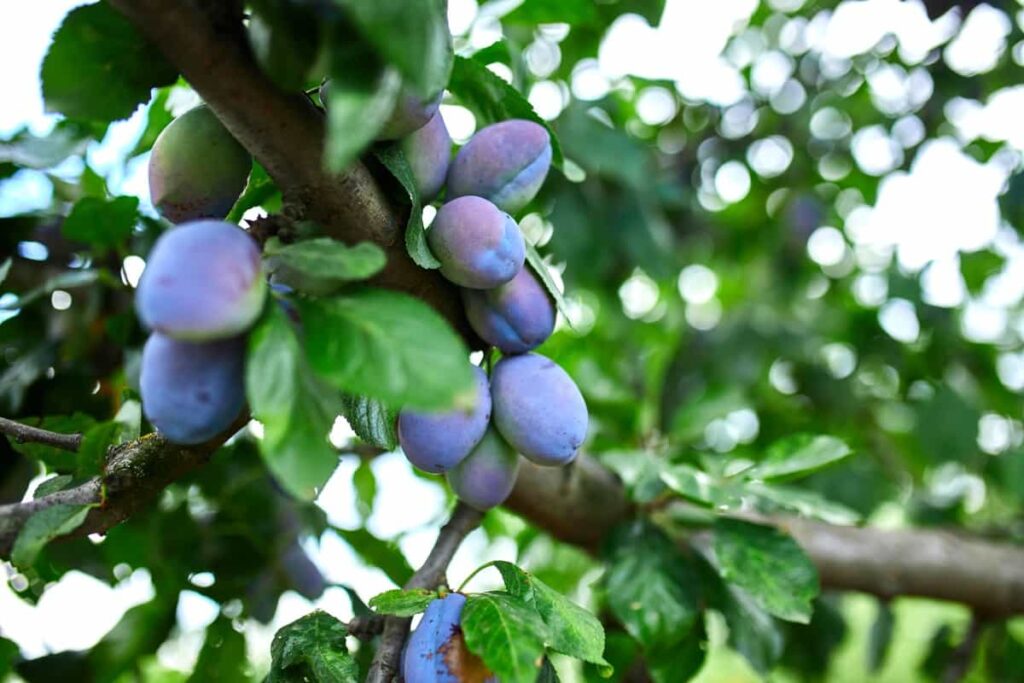
Conclusion
Effective management of plum fruit orchards requires meticulous month-wise planning. From rootstock selection and propagation to pruning, irrigation, and fertilization, following a comprehensive maintenance guide ensures optimal growth, productivity, and fruit quality throughout the year.
- Sheep Farming Business Plan for Beginners
- Aquaponic Farming at Home: A Step-By-Step Guide
- Profitable Village Farming Business Ideas in 2024
- High-Yield Aquaculture: Fast-Growing Fish for Farming
- Effective Fish Pond Construction Techniques for Beginners
- Irrigation and Water Management in Pineapple Farming
- Blossom to Harvest: Mastering Flowering and Pollination in Papaya Farming
- Pig Fattening Essentials: From Selection to Sale for Beginners
- Raising Wagyu Cattle: A Complete Guide for Premium Beef Production
- Soil Types and Their Water Holding Capacity
- Optimizing Irrigation Schedules for Coconut Groves for Enhanced Yield
- Espresso Your Garden: Coffee Grounds for Healthier Acid-Loving Plants
- The Best Soil Mix for Snake Plants: How to Mix Your Own Snake Plant Soil
- Green Thumb Success: Expert Tips for Cultivating Greenhouse Beans All Year Round
- Bloom All Year Round: The Ultimate Guide to Indoor Hyacinth Care
- Eco-Friendly Gardening: How to Make Liquid Fertilizer from Kitchen Waste
- Ultimate Guide to Grow Anise in Pots: Explore Seed Propagation to Harvesting
- Guide to Raising Chester White Pigs: Discover Breed Facts to Growth Management
- Mastering the Elegance: The Ultimate Guide to Weeping Cherry Tree Care, Planting, and Maintenance
- Ultimate Guide to Planting Garlic in Grow Bags: Growing Strategies for Beginners
- How to Fix Spider Plant Leaf-Related Problems: Natural and Organic Remedies
- 10 Reasons Why Your Tulsi Plant is Shedding Leaves: Home Remedies and Solutions
- Optimizing Growth and Yield: The Advantages of Palm Bunch Ash Fertilizer
- Utilizing Neem Oil Extract as a Natural Pesticide for Hydrangea
- From Soil to Harvest: Various Ways in Which Farmers Can Use AI Tools
- Steps to Encourage and Induce Citrus Flowers: A Comprehensive Guide
- How to Fix Snake Plant Leaf-Related Issues: Natural and Organic Remedies
- Transform Your Garden into a Fragrant Oasis with Raat Ki Rani (Night Blooming Jasmine)
- Discover the Ideal Chicken Breeds for Philippine Farms
- How to Create a Poultry Egg Farm Business Plan for Profits
- Grow Lemon Cucumbers Like a Pro: Insider Techniques for Bountiful Yields
- Ultimate Guide to Caring for Your Pink Princess Philodendron: Tips for Thriving Variegation
- Areca Nut Profit Per Acre: Calculating Yield and Cost of Cultivation
- How Kaveri Chicken is Becoming a More Profitable Breed in Indian Backyards
- Transform Your Barn: 9 Steps to Convert a Horse Stall into a Chicken Coop
- Exploring Suffolk Sheep Disadvantages with Limitations and Challenges
